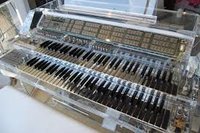I wonder how fast the switch could multiplex between the disks. The access requests for the other disk must be queued in the meantime somehow. There could be a great increase of access latency
Gesendet von meinem SM-N9005 mit Tapatalk
These are very round ballpark numbers presented for illustrative not quantitative thought.
Assuming:
The eMMC is rated at ~120MB/s average over sustained read/write.
Assuming a current generation microSD card, it is rated at 75MB/s average over sustained read/write.
first half - accounting for marketing: Nothing ever performs continuously at it's top rated speeds - and I'm after the worst case scenario. So, assume that half of the rated transfer rates are realistic and the rated values are peaks used for marketing.
60MB/s and 37.5MB/s.
second half - accounting for scenario: A plausible worst case scenario is going to be copying a file from eMMC to microSDXC while at the same time copying a file from microSDXC to the eMMC. It should fully saturate the bus and any caching. I'm going to make the brash assumption that this will half the performance of either media.
30MB/s and 18.75MB/s
third half - accounting for the multiplexer: Since both media are being controlled through the same bus, it is safe to assume that there will be about 50% of the 'normal' throughput to each type of media. Could be as low as 40% for switching overhead, but I like working in more round numbers and was aggressive in the first & second halfs.
15MB/s and 9.375MB/s
10-15MB/s oh my - well, not really.
- That is still faster than most cards could work with the Pandora when it came out.
- That is about the same speed as big computer HDDs were capable in Y2K. http://www.tomshardware.com/reviews/15-years-of-hard-drive-history,1368-7.html
- This is an insanely overblown worst case scenario where the user is doing something known to be 'slow' - copying directly between these two mount points - which should be an incredibly rare need.
So, I'm looking forward to someone creating a driver for this. I think it is going to be very very cool.



